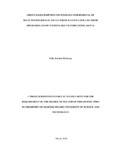| dc.description.abstract | The presence of pharmaceuticals (PHCs) in wastewater, surface and ground water systems has instigated great environmental concern due to the toxicological effects associated with these compounds. Conventional wastewater treatment technologies have been shown to be inadequate in removing these chemicals. It is therefore imperative to incorporate efficient, cost-effective and green remediation technologies in treatment of wastewater to maintain a safe and sustainable environment. In this study, novel magnetically engineered green adsorbent composites of diatomaceous earth (α-Fe2O3-DTE), carbonized bagasse (α-Fe2O3-CBG) and carbonized maize cobs (β-FeO(OH)-CMC) were developed for removal of selected PHCs in wastewater. The synthesized composites were characterized. The concentrations and discharge loads of selected PHCs (ampicillin, sulfamethoxazole, chloramphenicol, carbamazepine, lamivudine, aspirin and diclofenac) within Lake Victoria Basin of Kenya were determined. Samples were extracted by solid phase extraction and analyzed using hyphenated liquid chromatography-mass spectrometry (LC-MS). Residue levels of selected PHCs from Wastewater Treatment Plant (WWTP) effluents ranged from <0.05±0.02 to 0.36±0.04 μg/L. Hospital effluents had levels between <0.05±0.02 to 0.79±0.07 μg/L. PHC concentrations in water from streams and rivers receiving water from WWTPs ranged from <0.05±2 to 0.29±0.02 μg/L. Sediments collected from the riverbeds recorded PHC levels of <50±2 to 94±3 ng/g. Sludge samples from WWTPs had PHCs between <50±2 to 154±9 ng/g, while hospital lagoons had residues between <50±2 to 276±12 ng/g. The daily discharge loads of selected PHCs from the nine WWTPs studied ranged from 123.3±0.3 mg/L to 3130.0± mg/L. The mean percentage removal of the selected PHCs in conventional aerated lagoons was 36.92±0.78 % for the selected WWTPs. Adsorbent properties were determined. Powder X-ray diffraction (XRD) results showed the crystalline structure of α-Fe2O3 and β-FeO(OH) in modified composites of α-Fe2O3-DTE, α-Fe2O3-CBG and β-FeO(OH)-CMC, respectively. The scanning electron microscopy coupled with energy dispersive analysis X-ray (SEM-EDAX) together with X-ray fluorescence (XRF) spectroscopic results showed increased percentage of iron in the modified adsorbents indicating successful impregnation with iron. Fourier transform infrared (FTIR) spectroscopy revealed the presence of hydroxyl, carbonyl and iron oxide groups on the modified sorbents. The Brunauer–Emmet–Teller (BET) surface areas for the three modified adsorbents were 22.0097 m2g-1, 2.0741 m2g-1 and 2.58 m2g-1, respectively. The Barrett-Joyner-Halenda (BJH) desorption surface areas were 20.4619 m2g-1, 1.2504 m2g-1 and 2.0601 m2g-1. Gibbs free energy calculations confirmed the adsorption was energetically favourable and spontaneous with a high preference for adsorption on α-Fe2O3-DTE. Kinetic results showed multi-mechanistic adsorption sequences with the data tending to conform with the Langmuir model for α-Fe2O3-DTE while α-Fe2O3-CBG and β-FeO(OH)-CMC best fitted the Freundlich model. The adsorption capacity of carbamazepine was 90.15 %, 60.9 % and 43 % within a period of 180 minutes for the three sorbents, respectively. CBZ adsorption obeyed pseudo-second-order kinetics for all the composites with R2 values of 1.000, 0.998 and 0.976 for the tree composites, respectively. The fabricated composites exhibited excellent ferromagnetic properties thus providing alternative cost-effective technology for the efficient management of CBZ and other toxic organic pollutants in the environment. | en_US |

